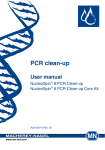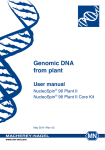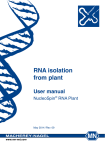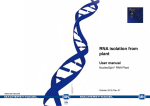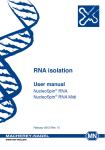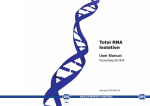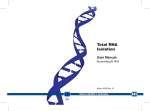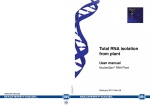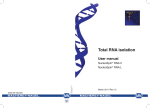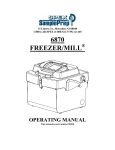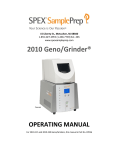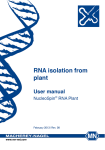Download NucleoSpin® 8 RNA - MACHEREY
Transcript
Total RNA isolation User manual NucleoSpin® 8 RNA NucleoSpin® 8 RNA Core Kit April 2014 / Rev. 05 Total RNA isolation Table of contents 1 Components 4 1.1 Kit contents 4 1.2 Reagents to be supplied by user 5 2 Product description 6 2.1 The basic principle 6 2.2 Kit specifications 6 2.3 Yield and quality of total RNA 6 2.4 Required hardware 8 ® 2.5 Recommended accessories for use of the NucleoSpin 8 RNA Core Kit 9 2.6 Automated processing on robotic platforms 10 2.7 Sample torage and homogenization 11 2.8 Elution of pure total RNA 13 3 Storage conditions and preparation of working solutions 14 4 Safety instructions 16 5Protocols 18 5.1NucleoSpin® 8 RNA – vacuum processing ® 5.2NucleoSpin 8 RNA – centrifuge processing 18 25 5.3 Automated purification using common laboratory automation workstations 30 5.4 Clean-up of total RNA 6Appendix 32 33 6.1Troubleshooting 33 6.2 Ordering information 35 6.3 Product use restriction / warranty 36 MACHEREY-NAGEL – 04/ 2014, Rev. 05 3 Total RNA isolation 1 Components 1.1 Kit contents NucleoSpin® 8 RNA 1 2 3 4 12 x 8 preps 60 x 8 preps REF 740698 740698.5 Lysis Buffer RA1 60 mL 250 ml Wash Buffer RA2 60 mL 360 ml Wash Buffer RA3 (Concentrate)1 50 mL 2 x 100 ml Wash Buffer RA4 (Concentrate)1 65 mL 3 x 65 ml Reaction Buffer for rDNase 30 mL 2 x 60 ml rDNase, RNase-free (lyophilized)1 2 vials 10 vials RNase-free H2O 30 mL 125 ml NucleoSpin® RNA Binding Strips (blue rings) 12 60 Collection Tubes (1.5 ml)2 8 40 MN Wash Plates (including six Paper Sheets)3 2 5 Racks of Tube Strips with Cap Strips4 3 15 MN Square-well Blocks 2 2 Elution Plates U-Bottom (including one Self-adhering PE Foil) 1 5 User manual 1 1 For preparation of working solutions and storage conditions see section 3. For rDNase working solution during automated use Is not used when following the centrifuge protocol in section 5.4 for the isolation of total RNA. Set consists of 1 Rack, 12 Tube Strips with 8 tubes each, and 12 Cap Strips. 4 MACHEREY-NAGEL – 04 / 2014, Rev. 05 Total RNA isolation 1.1 Kit contents continued NucleoSpin® 8 RNA Core Kit 48 x 8 preps REF 740465.4 Lysis Buffer RA1 2 x 125 mL Wash Buffer RA2 360 mL Wash Buffer RA3 (Concentrate)1 2 x 100 mL Wash Buffer RA4 (Concentrate)1 2 x 65 mL Reaction Buffer for rDNase 60 mL rDNase, RNase-free (lyophilized)1 8 vials RNase-free H2O 2 x 125 mL NucleoSpin® RNA Binding Strips (blue rings) 48 User manual 1 1.2 Reagents to be supplied by user • 96–100% ethanol (for preparation of working solutions; see section 3) • NucleoSpin® RNA Filter Strips (optional; see section 2.7) • Reducing agent (ß-mercaptoethanol, or DTT (dithiothreithol), or TCEP (BisTris (Bis-(2-hydroxyethyl)-imino-tris(hydroxymethyl)-methane)) as supplement for Lysis Buffer RA1 For more detailed information regarding special hardware required for centrifuge or vacuum processing, please see section 2.4. For ordering information, please see section 6.2. For recommended accessories for use of the flexible NucleoSpin® 8 RNA Core Kit (reduced kit composition; REF 740465.4), please see section 2.5. 1 For preparation of working solutions and storage conditions see section 3. MACHEREY-NAGEL – 04/ 2014, Rev. 05 5 Total RNA isolation 2 Product description 2.1 The basic principle One of the most important aspects while working with RNA is to prevent RNA degradation during the isolation procedure. With the NucleoSpin® 8 RNA kits, cells or tissues are lysed by incubation in a solution containing large amounts of chaotropic salt. This lysis buffer immediately inactivates RNases which are present in virtually all biological materials. In combination with Buffer RA4, it furthermore creates the appropriate binding conditions that favor RNA adsorption to the silica membrane. Contaminating DNA, which is also bound to the silica membrane, is removed by directly applying DNase onto the silica membrane during the preparation (RNase-free recombinant DNase is supplied with the kit). Salts, proteins, and other cellular components are removed by simple washing steps with three different buffers. Finally, pure RNA is eluted under low ionic strength conditions with RNase-free water (supplied). 2.2 Kit specifications • The NucleoSpin® 8 RNA kits are designed for fast 8-well small-scale purification of total RNA from tissue or cells. Fresh, frozen, or stabilized sample material can be processed. • The NucleoSpin® 8 RNA kits can be used manually under vacuum or under centrifugation. • The NucleoSpin® 8 RNA kits can be used fully automated on common laboratory workstations (see section 2.6). • The kits provide reagents and consumables for purification of up to 100 μg highly-pure total RNA suitable for direct use in standard molecular biology applications, like RT-PCR, TaqMan, Northern Blot, or microarray analysis. • The NucleoSpin® 8 RNA kits yield RNA of highest purity and integrity. • Using the NucleoSpin® 8 RNA kits allows for simultaneous processing of up to 48 samples typically within less than 45 minutes. Actual automated processing time depends on the configuration of workstation used. 2.3 Yield and quality of total RNA • 6 NucleoSpin® 8 RNA can be used under vacuum or in a centrifuge. In a centrifuge, however, slightly higher yields are possible because of the higher amount of starting material that can be processed and the reduced dead volume of the membrane. MACHEREY-NAGEL – 04 / 2014, Rev. 05 Total RNA isolation • Typical amounts of starting material and anticipated yields are shown in Table 2. Please note that yield of total RNA strongly depends on the starting material and on complete lysis / homogenization. Results may vary. For more information about the lysis / homogenization process, see section 2.7. Table 2: Kit specifications at a glance Parameter NucleoSpin® 8 RNA Technology Silica membrane technology Format Processing 8-well strips Manual or automated, vacuum or centrifugation Animal tissue Max. sample size Typical yield Cell culture Vacuum Centrifuge Vacuum Centrifuge 10–30 mg 30 mg 2 x 106 cells 1 x 107 cells Up to 40 μg Up to 100 μg Up to 20 μg Up to 100 μg Fragment size > 200 nt A260 / A280 1.9–2.1 Typical RIN (RNA integrity number) Typical concentration Elution volume Sharp rRNA bands with no substantial degradative bands visibile; 28S:18S ~ 2.1 Excellent RNA Integrity Number (RIN) values typically: > 9 (cells), ≥ 7 (tissue) 50–200 ng/μL 50–130 μL Preparation time 45 min/6 strips Binding capacity 100 μg • The final concentration of eluted RNA is 50–500 ng/μL (depending on elution volume and starting material). Suitable elution volumes range from 50 μL to 130 μL. For RNA purity typically, the A260 / A280 ratio is 1.9–2.1. • Isolated RNA is of highest quality and integrity indicating a highly efficient inactivation of RNases and gentle purification. MACHEREY-NAGEL – 04/ 2014, Rev. 05 7 Total RNA isolation 2.4 Required hardware NucleoSpin® 8 RNA can be processed under vacuum or centrifugation. Certain hardware for processing is required. Centrifugation For processing the 8-well strips under centrifugation, the Starter Set C (see ordering information), containing Column Holders C, NucleoSpin® Dummy Strips, MN Squarewell Blocks, and Rack of Tube Strips is required. For centrifugation with Column Holder C (with inserted NucleoSpin® RNA Binding Strips) stacked on a MN Square-well Block or Rack of Tube Strips, a microtiter plate centrifuge is required which is able to accommodate the above stacked plates and reach accelerations of 5,600–6,000 x g (bucket height: 85 mm). Regarding waste collection, suitable consumables (e.g., MN Square-well Blocks) are necessary and they are not included in the kit. For the most convenient handling, without the need of emptying and reusing the MN Square-well Blocks, we recommend using six MN Square-well Blocks if two column holders are processed at once (see ordering information). Alternatively, it is possible to empty the MN Square-well Blocks after every centrifugation step, reducing the amount of MN Square-well Blocks needed. Vacuum processing For processing 8-well strips under vacuum, the Starter Set A (see ordering infomation), containing Column Holders A and NucleoSpin® Dummy Strips is required. For automation on laboratory platforms with standard 96-well plate manifolds, the use of Starter Set A is also required. The NucleoSpin® 8 RNA kit can be used manually with the NucleoVac 96 Vacuum Manifold (see ordering information). Establish a reliable vacuum source for the NucleoVac 96 Vacuum Manifold. The manifold may be used with a vacuum pump, house vacuum, or water aspirator. We recommend a vacuum of -0.2 to -0.4 bar (reduction of atmospheric pressure). The use of the NucleoVac Vacuum Regulator (see ordering information) is recommended. Alternatively, adjust the vacuum so that during the purification the sample flows through the column with a rate of 1–2 drops per second. Depending on the amount of sample being used, the vacuum times may need to be increased for complete filtration. Additionally, a suitable centrifuge for sample preparation steps may be required. 8 MACHEREY-NAGEL – 04 / 2014, Rev. 05 Total RNA isolation 2.5 Recommended accessories for use of the NucleoSpin® 8 RNA Core Kit The NucleoSpin® 8 RNA Core Kit provides buffers, rDNase, and NucleoSpin® RNA Binding Strips. Accessory plates (e.g., lysis plates, elution plates) are not provided with the core kit. The reduced kit composition along with a variety of separately available accessories, allow optimal adjustment of the kit to individual user needs. The user can select additional consumables according to his / her requirements for highest flexibility. For use of NucleoSpin® 8 RNA Core Kit, follow the standard protocols (see section 5.1 and 5.2). Recommended accessories for use of the NucleoSpin® 8 RNA Core Kit (48 x 8 preps) are available from MACHEREY-NAGEL (see ordering information). Protocol step Suitable consumables, not supplied with the core kits Lyse samples 8 x Rack of Tubes Strips with Cap Strips per 48 x 8 preps Remarks or 8 x Round-well Block with Cap Strips per 48 x 8 preps or 8 x MN Square-well Block Bind RNA to the membrane 8 x MN Wash Plate per 48 x 8 preps MN Wash Plate minimizes the risk of cross contamination (vacuum processing only). 2 x MN Square-well Block For waste collection during centrifugation (reusable) MACHEREY-NAGEL – 04/ 2014, Rev. 05 9 Total RNA isolation Protocol step Suitable consumables, not supplied with the core kits Elute RNA 8 x Rack of Tubes Strips with Cap Strips per 48 x 8 preps Remarks or 8 x Round-well Block with Cap Strips per 48 x 8 preps or 8 x Elution Plate U-bottom or 8 x Round-well Block Low For vacuum processing only For processing under centrifugation 2.6 Automated processing on robotic platforms NucleoSpin® 8 RNA can be used fully automated on many common laboratory workstations. Please contact MN for the availability of scripts and general considerations about adapting NucleoSpin® 8 RNA on a certain workstation. Visit MN online at www.mn-net.com or contact your local MACHEREY-NAGEL distributor for technical support regarding hardware, software, setup instructions, and selection of the protocol. Several application notes of the NucleoSpin® 8 RNA kit on various liquid handling instruments can also be found at www.mn-net.com at Bioanalysis / Literature. Full processing under vacuum enables complete automation without the need of centrifugation steps for drying or elution. However, a final elution step by centrifugation is recommended in order to achieve higher concentrated DNA eluates. The risk of cross-contamination is reduced by optimized vacuum settings during the elution step and by the improved shape of the outlets of the NucleoSpin® RNA Binding Strips. Drying of the NucleoSpin® RNA Binding Strips only under vacuum is sufficient, as the bottom of the plate is protected by the MN Wash Plate during the washing steps. As a result, it is recommended integrating the MN Wash Plate into the automated procedure. The MN Frame (see ordering information) can be used to place the disposable MN Wash Plate inside the vacuum chamber. This also reduces the risk of cross-contamination, as common metal adaptors tend to get contaminated by gDNA. Thorough cleaning of the 10 MACHEREY-NAGEL – 04 / 2014, Rev. 05 Total RNA isolation vacuum chamber is recommended after each run to prevent DNA-containing aerosols from forming. 2.7 Sample torage and homogenization RNA is not protected against digestion until the sample material is flash frozen or disrupted in the presence of RNase inhibiting or denaturing agents. Therefore, it is important that samples are either immediately frozen and stored at -70 °C, placed in a RNA stabilizing reagent (not included in the kit), or processed as soon as harvested. After disruption samples can be stored at -70 °C in Lysis Buffer RA1. Frozen samples are stable for up to 6 months. Frozen samples in Buffer RA1 should be thawed completely and centrifuged before starting with the isolation of total RNA. If larger cell numbers or large amounts of tissue are used, a filtration step of the RA1 lysate through the NucleoSpin® RNA Filter Strips (see ordering information) is recommended for optimal homogenization and removal of particles. Cell culture • Up to 2 x 106 cells can be processed under vacuum. Using a centrifuge, up to 1 x 107 cells can be processed. Transfer the cell suspension to a suitable square-well block (not included in the kit) and centrifuge for 5 min at 500 x g. The supernatant has to be removed completely. Lyse cells by addition of 300 μL Buffer RA1. Follow the standard protocol for cell cultures. • For adherent cell cultures in 96-well format, make sure that the culture medium is completely removed. Lyse cells by addition of 130 μL Buffer RA1. Follow the standard protocol for cell cultures grown in 96-well plates. • If using more than 1 x 106 cells, it is recommended using a commercial homogenizer for lysis with Buffer RA1 in order to reduce viscosity. To prevent the NucleoSpin® RNA Binding Strips from clogging, it is also recommended filtrating the lysates through the NucleoSpin® RNA Filter Strips (not included in the kit) before applying them to the NucleoSpin® RNA Binding Strips. Tissue • Depending on the type of sample, up to 30 mg (see also Table 2) can be processed. Add 300 μL Buffer RA1 for tissue homogenization. Follow the standard protocol for tissue samples. • If working with tissue or nuclease-rich cells, add 1 % ß-mercaptoethanol to Buffer RA1. ß-mercaptoethanol supports the inhibition of RNases. • For sample homogenization and removal of cell debris, it is recommended filtering the lysates through the NucleoSpin® RNA Filter Strips (not included in the kit) before applying them to the NucleoSpin® RNA Binding Strips. Alternatively: Centrifuge homogenized tissue samples for 5 min at maximum MACHEREY-NAGEL – 04/ 2014, Rev. 05 11 Total RNA isolation g-forces, transfer supernatant to suitable plate, and proceed with the standard protocol by adding Buffer RA4. • Binding capacity of the membrane is up to 100 μg. Depending on type of tissue and homogenization, yield will differ and has to be tested individually. Some typical results are depicted in the following table: Table 3: Yields of total RNA with NucleoSpin® 8 RNA Sample source Max. starting material Max. yield of total RNA Spleen 20 mg 50 μg Kidney 30 mg 45 μg Brain 30 mg 20 μg Liver 30 mg 80 μg Yield of total RNA depends strongly on the tissue and the effectiveness of lysis / homogenization. Therefore, results may strongly vary. Methods for sample homogenization • Commercial homogenizers, for example, 2010 Geno / Grinder (COPS Diagnostics) can be used for sample homogenization. Use of NucleoSpin® RNA Filter Strips • For sample homogenization and to prevent clogging of the NucleoSpin® RNA Binding Strips, the use of the NucleoSpin® RNA Filter Strips is recommended under vacuum or centrifugation. Centrifugation Insert desired number of NucleoSpin® RNA Filter Strips into the Column Holder C (see ordering information) and place it on a MN Square-well Block (Starter Set C, see ordering information). Transfer lysates in Buffer RA1 to the wells of the NucleoSpin® RNA Filter Strips. Centrifuge at 5,600–6,000 x g until all samples have passed the filter (approx. 5 min). Start the RNA purification procedure with the filtrate collected in the MN Square-well Block. Vacuum Insert spacers ‘SQUARE-WELL BLOCK’ into the NucleoVac 96 Vacuum Manifold. Put a Square-well Block in the manifold and close the manifold with the manifold lid. Insert desired number of NucleoSpin® RNA Filter Strips into the Column Holder A (Starter Set A, see ordering information) and place it on top of the manifold. 12 MACHEREY-NAGEL – 04 / 2014, Rev. 05 Total RNA isolation Transfer the sample lysate in Buffer RA1 to the filter and apply vacuum until the lysates have passed the filter. Start the RNA purification procedure with the flowthrough collected in the MN Square-well Block. Please note that the dead volume of the NucleoSpin® RNA Filter Strips is rather large compared to the processing under centrifugation, thus processing under vacuum is only recommended when complete automation is desired. 2.8 Elution of pure total RNA Due to dead volume of the silica membrane by using vacuum, please notice that the difference between the dispensed elution buffer and the recovered elution buffer containing total RNA is approx. 20 μL. For RNA elution, a volume of 50–130 μL nuclease free water is recommended. Higher RNA concentrations are obtained when using a dispense volume of 50 μL, however, higher elution efficiencies are obtained when using dispense volumes of > 100 μL. Recovered elution volume = Dispensed elution volume - 20 μL Elution is possible under vacuum and in a centrifuge without any cross-contamination (see Figure 1). To achieve this, vacuum settings during the elution have to be adjusted carefully (smooth elution) to avoid splattering of liquid. Figure 1: HeLa cells (5 x 105 each) were pelleted in a culture plate in a chess board pattern. Total RNA was prepared using NucleoSpin® 96 RNA. (a) RT-PCR detection of total RNA was performed with 1.5 μL of the eluate (total eluate 80 μL) in a LightCycler® (0.5 μM GAPDH primer, LightCycler®-RNA Amplification Kit Hybridization Probes). (b) 20 μL of the LightCycler® assay were loaded on a 2 % agarose gel. +: Total RNA from 5 x 105 HeLa cells –: Empty control well (next to a well containing cells) a: 200 bp product of the GAPDH gene b<<<<<<<<: Primers MACHEREY-NAGEL – 04/ 2014, Rev. 05 13 Total RNA isolation 3 Storage conditions and preparation of working solutions Attention: Buffers RA1 and RA2 contain chaotropic salts. Wear gloves and goggles! CAUTION: Buffers RA1 and RA2 contain guanidinium thiocyanate which can form highly reactive compounds when combined with bleach (sodium hypochlorite). DO NOT add bleach or acidic solutions directly to the sample-preparation waste. Storage conditions: • Store lyophilized RNase-free rDNase at 4 °C on arrival (stable for at least one year). • All other components of the NucleoSpin® 8 RNA kit should be stored at room temperature and are stable for at least one year. Storage at lower temperatures may cause precipitation of salts. If a salt precipitate is observed, incubate the bottle at 30–40 °C for some minutes and mix well until all of the precipitate is redissolved. Before starting with any NucleoSpin® 8 RNA protocol, prepare the following: 14 • Reconstitute RNase-free rDNase: Add 540 μL RNase-free H2O to the rDNase vial and incubate for 1 min at room temperature. Gently swirl the vial to completely dissolve the rDNase. In case of not processing a whole 96-well plate, dispense the reconstituted rDNase solution into aliquots and store at -20 °C. This rDNase solution is stable for at least six months. Do not freeze / thaw the aliquots more than three times. Prepare rDNase reaction mixture: For each sample to be processed mix 10 μL reconstituted rDNase with 90 μL Reaction Buffer for rDNase. • Wash Buffer RA3: Add the indicated volume of 96–100 % ethanol to the Buffer RA3 Concentrate. Indicate that ethanol is added by marking the bottle label. Store Wash Buffer RA3 at room temperature (18–25 °C) for at least one year. • Wash Buffer RA4: Add the indicated volume of 96–100 % ethanol to the Buffer RA4 Concentrate. Mark the bottle label to indicate that ethanol has been added. Store Wash Buffer RA4 at room temperature (18–25 °C) for at least one year. MACHEREY-NAGEL – 04 / 2014, Rev. 05 Total RNA isolation NucleoSpin® 8 RNA 12 x 8 preps 60 x 8 preps 740698 740698.5 Wash Buffer RA3 (Concentrate) 1 x 50 mL Add 200 mL ethanol 2 x 100 mL Add 400 mL ethanol to each bottle Wash Buffer RA4 (Concentrate) 1 x 65 mL Add 150 mL ethanol 2 x 65 mL Add 150 mL ethanol to each bottle REF NucleoSpin® 8 RNA Core Kit 48 x 8 preps REF 740465.4 Wash Buffer RA3 (Concentrate) 2 x 100 mL Add 400 mL ethanol to each bottle Wash Buffer RA4 (Concentrate) 2 x 65 mL Add 150 mL ethanol to each bottle MACHEREY-NAGEL – 04/ 2014, Rev. 05 15 Total RNA isolation 4 Safety instructions The following components of the NucleoSpin® 8 RNA and NucleoSpin® 8 RNA Core kits contain hazardous contents. Wear gloves and goggles and follow the safety instructions given in this section. GHS classification Only harmful features do not need to be labeled with H and P phrases up to 125 mL or 125 g. Mindergefährliche Eigenschaften müssen bis 125 mL oder 125 g nicht mit H- und P-Sätzen gekennzeichnet werden. Component Hazard contents GHS symbol Hazard Precaution phrases phrases Inhalt Gefahrstoff GHS Symbol H-Sätze P-Sätze RA1 Guanidinium thiocyanate 30–60 % Warning Guanidiniumthiocyanat 30–60 % Achtung 302, 412, EUH031 260, 273, 301+312, 330 Guanidinium thiocyanate 30–60 % + ethanol 2035 % Warning 226, 302, 412, EUH031 210, 233, 260, 273, 301+312, 330, 403+235 317, 334 261, 280, 302+352, 304+340, 333+313, 342+311, 363 RA2 rDNase, RNase-free Guanidiniumthiocyanat 30–60 % + Ethanol 20–35 % Achtung rDNase, lyophilized Danger rDNase, lyophilisiert Gefahr Hazard phrases H 226 Flammable liquid and vapour. H 302 Harmful if swallowed. H 317 May cause an allergic skin reaction. H 334 May cause allergy or asthma symptoms or breathing difficulties if inhaled. H 412 Harmful to aquatic life with long lasting effects. EUH031 Contact with acids liberates toxic gas. Flüssigkeit und Dampf entzündbar. Gesundheitsschädlich bei Verschlucken. Kann allergische Hautreaktionen verursachen. Kann bei Einatmen Allergie, asthmaartige Symptome oder Atembeschwerden verursachen. Schädlich für Wasserorganismen, mit langfristiger Wirkung. Entwickelt bei Berührung mit Säure giftige Gase. * Hazard labeling not neccessary if quantity per bottle below 125 g or ml (certificate of exemption according to 67/548/EEC Art. 25, 1999/45/EC Art. 12 and German GefStoffV § 20 (3) and TRGS 200 7.1). For further information see Material Safety Data Sheet. 16 MACHEREY-NAGEL – 04 / 2014, Rev. 05 Total RNA isolation Precaution phrases P 210 Keep away from heat, hot surfaces, sparks, open flames and other ignition sources. No smoking. Von Hitze, heißen Oberflächen, Funken, offenen Flammen sowie anderen Zündquellenarten fernhalten. Nicht rauchen. P 233 Keep container tightly closed P 260 Do not breathe vapours. P 261 Avoid breathing dust. P 273 Avoid release to the environment. P 280 Wear protective gloves / eye protection. P 301+312 IF SWALLOWED: Call a POISON CENTER/ doctor/…/if you feel unwell. P 302+352 IF ON SKIN: Wash with plenty of water/… P 304+340 IF INHALED: Remove victim to fresh air and keep at rest in a position comfortable for breathing. Behälter dicht verschlossen halten. Dampf nicht einatmen. Einatmen von Staub vermeiden. Freisetzung in die Umwelt vermeiden. Schutzhandschuhe / Augenschutz tragen. BEI VERSCHLUCKEN: Bei Unwohlsein GIFTINFORMATIONSZENTRUM / Arzt /… anrufen. BEI KONTAKT MIT DER HAUT: Mit viel Wasser/… waschen. Bei Einatmen: An die frische Luft bringen und in einer Position ruhigstellen, die das Atmen erleichtert. P 330 Rinse mouth. P 333+313 IF skin irritation or a rash occurs: Get medical advice / attention. P 342+311 If experiencing respiratory symptoms: Call a POISON CENTER/ doctor/… P 403+235 Store in a well ventilated place. Keep cool. P 363 Wash contaminated clothing before reuse. Mund ausspülen. Bei Hautreizung oder -ausschlag: Ärztlichen Rat einholen / ärztliche Hilfe hinzuziehen. Bei Symptomen der Atemwege: GIFTINFORMATIONSZENTRUM /Arzt/… anrufen. Kühl an einem gut belüfteten Ort augbewahren. Kontaminierte Kleidung vor erneutem Tragen waschen. For further information please see Material Safety Data Sheets (www.mn-net.com). Weiterführende Informationen finden Sie in den Sicherheitsdatenblättern (www.mn-net.com). MACHEREY-NAGEL – 04/ 2014, Rev. 05 17 NucleoSpin® 8 RNA – vacuum processing 5 Protocols 5.1 NucleoSpin® 8 RNA – vacuum processing • For hardware requirements, refer to section 2.4. • For detailed information about each step, see page 24. • • For detailed information regarding the vacuum manifold setup, see page 23. For use of the NucleoSpin® 8 RNA Core Kit (REF 740465.4), refer to section 2.5 regarding recommended accessories. Before starting the preparation: • Check if Buffer RA3, Buffer RA4, and rDNase reaction mixture were prepared according to section 3. Protocol-at-a-glance 1 Harvest cells 500 x g, 5 min 2 Lyse cells or tissue Optional: If using tissue samples or large number of cells, clearing of lysate with the NucleoSpin® RNA Filter Strips is recommended Transfer cleared lysate to MN Squarewell Block 3 Prepare binding Mix by pipetting up and down at least 10–15 times 300 μL RA1 (cells, tissue) (+ 3 μL ß-ME) or 130 μL RA1 (cells)1 (+ 1.3 μL ß-ME) 300 μL RA4 (cells, tissue) or 130 μL RA4 (cells)1 Prepare vacuum manifold 1 2 4 Transfer crude lysates to NucleoSpin® RNA Binding Strips 5 Bind RNA to silica membrane of the NucleoSpin® RNA Binding Strips -0.2 bar2, 1 min Cells grown in 96-well plates only Reduction of atmospheric pressure 18 MACHEREY-NAGEL – 04 / 2014, Rev. 05 NucleoSpin® 8 RNA – vacuum processing 6 Desalt silica membrane by washing 500 μL RA3 -0.2 bar1, 3 min 7 Digest DNA 95 μL rDNase reaction mixture Room temperature, 15 min 8 Wash silica membrane 500 μL RA2 800 μL RA3 500 μL RA4 -0.2 bar1, 1 min each step Remove MN Wash Plate 9 Dry NucleoSpin® RNA Binding Strips by applying vacuum Maximum vacuum (-0.6 bar1), 10 min Optional: Dry the outlets of the NucleoSpin® RNA Binding Strips by placing it on a Paper Sheet before applying vacuum 10 75 μL RNase-free H2O Elute RNA Incubate 2 min -0.5 bar1, 1 min 1 Reduction of atmospheric pressure MACHEREY-NAGEL – 04/ 2014, Rev. 05 19 NucleoSpin® 8 RNA – vacuum processing Setup of vacuum manifold: Binding / Washing steps 20 Elution step Step 4: Place the NucleoSpin® Binding Strips inserted the Column Holder A on top of the manifold lid. Unused rows have to be filled with NucleoSpin® Dummy Strips. Step 4: Place the NucleoSpin® Binding Strips inserted the Column Holder A on top of the manifold lid. Unused rows have to be filled with NucleoSpin® Dummy Strips. Step 3: Place the manifold lid on top of the manifold base. Step 3: Place the manifold lid on top of the manifold base. Step 2: Place the MN Wash Plate in the manifold. Step 2: Place the Elution Plate in the manifold. Step 1: Insert spacers ‘MTP/MULTI-96 PLATE‘ and waste container in the manifold base. Step 1: Insert spacers ‘MTP/MULTI-96 PLATE‘ in the manifold base. Final setup Final setup MACHEREY-NAGEL – 04 / 2014, Rev. 05 NucleoSpin® 8 RNA – vacuum processing Detailed protocol • For hardware requirements, refer to section 2.4. • For use of the NucleoSpin® 8 RNA Core Kit (REF 740465.4), refer to section 2.5 regarding recommended accessories. • For detailed information regarding the vacuum manifold setup, see page 23. Before starting the preparation: • Check if Buffer RA3, Buffer RA4, and rDNase reaction mixture were prepared according to section 3. 1 Harvest cells If cells have been grown in suspension, aliquots of up to 2 x 106 cells can be transferred into wells of a MN Square-well Block (included in the kit) or another suitable deep-well plate or reaction tube (e.g., Round-well Block, Rack of Tube Strips; see ordering information). Pellet cells by centrifugation (5 min, 500 x g), and remove the supernatant by pipetting. 2 Lyse cells or tissue Cells, tissue samples Add 300 μL Buffer RA1 / 1 % ß-mercaptoethanol [vol/vol] to each sample. Cells can be lysed by repeated pipetting up and down or vigorous shaking of the sealed / closed plate or reaction tube. For homogenization of tissue samples, please refer to section 2.7. Note: As alternative to ß-ME, the reducing agent DTT or TCEP may be used. Use a final concentration of 10–20 mM DTT or TCEP within the Lysis Buffer RA1. Optional: It is recommended using the NucleoSpin® RNA Filter Strips (see ordering information) for the clarification of tissue lysates. Cells cultures grown in 96-well plates Discard culture medium and if necessary, wash cells with PBS buffer once. Add 130 μL Buffer RA1 / 1 % ß-mercaptoethanol [vol/vol] to the cells in each well of the cell-culture plate. Cells can be lysed by repeated pipetting up and down or vigorous shaking of the sealed plate. Note: Use of ß-mercaptoethanol is recommended, but not essential for most cell types (also see section 2.7). MACHEREY-NAGEL – 04/ 2014, Rev. 05 21 NucleoSpin® 8 RNA – vacuum processing 3 Prepare binding Depending on the volume of Buffer RA1 used in the lysis step, add 300 μL or 130 μL Buffer RA4 (for lysates from cells grown in 96-well plates) to each well of the lysis plate or tube. Mix by pipetting up and down at least 10–15 times. Note: Buffer RA1 and Buffer RA4 have to be used in the same volume ratio. Prepare NucleoVac 96 Vacuum Manifold Insert appropriate number of NucleoSpin® RNA Binding Strips into a Column Holder A. Close any unused openings of the Column Holder A with NucleoSpin® Dummy Strips. Note: Make sure that the NucleoSpin® RNA Binding Strips are inserted tightly into the Column Holder A. Not properly inserted strips may prevent sealing when vacuum is applied to the manifold. Insert spacers (MTP / MULTI-96 PLATE), notched side up, into the grooves located on the short sides of the manifold. Insert the waste container into the center of the manifold. Place the MN Wash Plate on top of the spacers in the manifold base. Insert Column Holder A with inserted NucleoSpin® RNA Binding Strips into the manifold lid and place lid on the manifold base. 4 Transfer crude lysates to NucleoSpin® RNA Binding Strips Apply the samples to the wells of the NucleoSpin® RNA Binding Strips. 5 Bind RNA to silica membrane Apply vacuum until all lysates have passed through the wells (-0.2 bar1; 1 min). Release the vacuum. 6 Desalt silica membrane Desalt the membrane by adding 500 μL Buffer RA3 to each well and apply vacuum (-0.2 bar1; 3 min) until all buffer has passed through the wells. Release the vacuum. 1 Reduction of atmospheric pressure 22 MACHEREY-NAGEL – 04 / 2014, Rev. 05 NucleoSpin® 8 RNA – vacuum processing 7 Digest DNA Prepare rDNase reaction mixture as described in section 3: Pipette 95 μL rDNase reaction mixture directly to the bottom of each well of the NucleoSpin® RNA Binding Strips. Do not touch the silica membrane with the pipette tips. Incubate at room temperature for 15 min. Be sure that all of the rDNase reaction mixture gets into contact with the silica membrane, and that the membrane is completely wetted. 8 Wash silica membrane 1st wash Add 500 μL Buffer RA2 to each well of the NucleoSpin® RNA Binding Strips. Apply vacuum (-0.2 bar1; 1 min) until all buffer has passed through the wells. Release the vacuum. 2nd wash Add 800 μL Buffer RA3 to each well of the NucleoSpin® RNA Binding Strips. Apply vacuum (-0.2 bar1; 1 min) until all buffer has passed through the wells. Release the vacuum. 3rd wash Add 500 μL Buffer RA4 to each well of the NucleoSpin® RNA Binding Strips. Apply vacuum (-0.2 bar1; 1 min) until all buffer has passed through the wells. Release the vacuum. Remove MN Wash Plate After the final wash step, close the valve, release the vacuum and remove the Column Holder A with inserted NucleoSpin® RNA Binding Strips from the vacuum manifold. Put it on a clean paper towel to remove residual EtOH-containing wash buffer. Remove manifold lid, MN Wash Plate, and waste container from the vacuum manifold. 1 Reduction of atmospheric pressure MACHEREY-NAGEL – 04/ 2014, Rev. 05 23 NucleoSpin® 8 RNA – vacuum processing 9 Dry NucleoSpin® RNA Binding Strips Remove any residual wash buffer from the NucleoSpin® RNA Binding Strips. If necessary, tap the outlets of the NucleoSpin® RNA Binding Strips onto a clean Paper Sheet (supplied with the MN Wash Plate) or soft tissue until no further drops come out. Insert the Column Holder A with inserted NucleoSpin® RNA Binding Strips into the manifold lid and close the manifold. Build up the vacuum with the valve closed. Once the maximum vacuum (-0.6 bar1) is achieved, open the valve and apply vacuum for at least 10 min to dry the membrane completely. This step is necessary to eliminate traces of ethanol. Note: The ethanol in Buffer RA4 inhibits enzymatic reactions and has to be removed completely before eluting DNA. Finally, release the vacuum. 10 Elute RNA Place the Elution Plate U-bottom onto the spacers ‘MTP / MULTI-96 PLATE’ of the vacuum manifold. Pipette 75 μL RNase-free H2O directly to the bottom of each well (75 μL are recommended, 50–130 μL are possible, see section 2.8). Incubate for 2 min at room temperature. Build up the vacuum with the valve closed. Once the maximum vacuum (-0.5 bar1) is achieved, open the valve and apply vacuum for 1 min. Alternatively, elution into Tube Strips (included in the kit) or standard PCR plates is possible. For elution in Tube Strips, place the Rack of Tube Strips on the spacers ‘MICROTUBE STRIPS’ inside the manifold. Elution into PCR plates can be performed by placing a PCR plate onto a MN Square-well Block placed on the spacers ‘SQUARE-WELL BLOCK’ in the manifold. 1 Reduction of atmospheric pressure 24 MACHEREY-NAGEL – 04 / 2014, Rev. 05 NucleoSpin® 8 RNA – centrifuge processing 5.2 NucleoSpin® 8 RNA – centrifuge processing • For hardware requirements, refer to section 2.4. • For use of the NucleoSpin® 8 RNA Core Kit (REF 740465.4), refer to section 2.5 regarding recommended accessories. • For detailed information on each step, see page 30. Before starting the preparation: • Check if Buffer RA3, Buffer RA4, and rDNase reaction mixture were prepared according to section 3. Protocol-at-a-glance 1 Harvest cells 500 x g, 5 min, 2 Lyse cells or tissue Optional: If using tissue samples or large number of cells, clearing of lysate with the NucleoSpin® RNA Filter Strips is recommended Centrifuge 5,600–6,00 x g for 5 min 3 Prepare binding Mix by pipetting up and down at least 10–15 times 300 μL RA1 (cells, tissue) (+ 3 μL ß-ME) or 130 μL RA1 (cells)1 (+ 1.3 μL ß-ME) 300 μL RA4 (cells, tissue) or 130 μL RA4 (cells)1 4 Transfer crude lysates to NucleoSpin® RNA Binding Strips 5 Bind RNA to silica membrane of the NucleoSpin® RNA Binding Strips 5,600–6,000 x g, 2 min 6 Desalt silica membrane by washing 500 μL RA3 5,600–6,000 x g, 2 min 1 Cells grown in 96-well plates only MACHEREY-NAGEL – 04/ 2014, Rev. 05 25 NucleoSpin® 8 RNA – centrifuge processing 7 Digest DNA 95 μL rDNase reaction mixture Room temperature, 15 min 8 Wash silica membrane 500 μL RA2 5,600–6,000 x g, 2 min 800 μL RA3 5,600–6,000 x g, 2 min 500 μL RA4 5,600–6,000 x g, 10 min1 9 Dry NucleoSpin® RNA Binding Plate 10 Elute RNA Not necessary 75 μL RNase-free H2O Incubate 2 min 5,600–6,000 x g, 2 min 1 Prolonged centrifugation time is required to remove al traces of ethanol from last wash step. 26 MACHEREY-NAGEL – 04 / 2014, Rev. 05 NucleoSpin® 8 RNA – centrifuge processing Detailed protocol • • For hardware requirements, refer to section 2.4. For use of the NucleoSpin® 8 RNA Core Kit (REF 740465.4), refer to section 2.5 regarding recommended accessories. Before starting the preparation: • Check if Buffer RA3, Buffer RA4, and rDNase reaction mixture were prepared according to section 3. 1 Harvest cells If cells have been grown in suspension, aliquots of up to 1 x 107 cells can be transferred into the wells of a MN Square-well Block (included in the kit) or into the wells of another suitable deep-well plate or reaction tube (e.g., Round-well Block, Tube Strips; see ordering information). Pellet cells by centrifugation (5 min, 500 x g), and remove the supernatant by pipetting. 2 Lyse cells ot tissue Cells, tissue samples Add 300 μL Buffer RA1 / 1 % ß-mercaptoethanol [vol/vol] to each sample. Cells can be lysed by pipetting up and down repeatedly or vigorous shaking of the sealed / closed plate or reaction tube. For homogenization of tissue samples please refer to section 2.7. Note: As alternative to ß-ME, the reducing agent DTT or TCEP may be used. Use a final concentration of 10–20 mM DTT or TCEP within the Lysis Buffer RA1. Optional: It is recommended using the NucleoSpin® RNA Filter Strips (see ordering information) for the clarification of tissue lysates. Cells cultures grown in 96-well plates Discard culture medium and if necessary wash cells with PBS buffer once. Add 130 μL Buffer RA1 / 1 % ß-mercaptoethanol [vol/vol] to the cells in each well of the cell-culture plate. Cells can be lysed by pipetting up and down repeatedly or vigorous shaking of the sealed plate. Note: Use of ß-mercaptoethanol is recommended, but not essential for most cell types (also see section 2.7). MACHEREY-NAGEL – 04/ 2014, Rev. 05 27 NucleoSpin® 8 RNA – centrifuge processing 3 Prepare binding Depending on the volume of Buffer RA1 used in the lysis step, add 300 μL Buffer RA4 or 130 μL Buffer RA4 (for lysates from cells grown in 96-well plates), to each well of the lysis plate or tube. Mix by pipetting up and down at least 10–15 times. Note: Buffer RA1 and Buffer RA4 have to be used in the same volume ratio. 4 Transfer crude lysates to NucleoSpin® RNA Binding Strips Insert desired number of NucleoSpin® RNA Binding Strips into the Column Holder C and place on it a MN Square-well Block for collection of flow-through. If using more than one block, label the column holders for later identification. Transfer lysates to the wells of the NucleoSpin® RNA Binding Strips. 5 Bind RNA to silica membrane Centrifuge for 2 min at 5,600–6,000 x g. 6 Desalt silica membrane Desalt the membrane by adding 500 μL Buffer RA3 to each well and centrifuge for 2 min at 5,600–6,000 x g. Empty MN Square-well Block. 7 Digest DNA Prepare rDNase reaction mixture as described in section 3: Place Column Holder C with the NucleoSpin® RNA Binding Strips on the MN Square-well Block. Pipette 95 μl rDNase reaction mixture directly to the bottom of each well of the NucleoSpin® RNA Binding Strips. Do not touch the silica membrane with the pipette tips. Incubate at room temperature for 15 min. Be sure that all of the rDNase reaction mixture gets into contact with the silica membrane, and that the membrane is completely wetted. 8 Wash silica membrane 1st wash Add 500 μl Buffer RA2 to each well of the NucleoSpin® RNA Binding Strips. Place the Column Holder C with the NucleoSpin® RNA Binding Strips on the MN Square-well Block into the rotor bucket and centrifuge for 2 min at 5,600– 6,000 x g. Empty MN Square-well Block. 28 MACHEREY-NAGEL – 04 / 2014, Rev. 05 NucleoSpin® 8 RNA – centrifuge processing 2nd wash Add 800 μL Buffer RA3 to each well of the NucleoSpin® RNA Binding Strips and centrifuge for or 2 min at 5,600–6,000 x g. Empty MN Square-well Block. 3rd wash Add 500 μL Buffer RA4 to each well of the NucleoSpin® RNA Binding Strips and centrifuge for or 10 min at 5,600–6,000 x g. Empty MN Square-well Block. 9 Dry NucleoSpin® RNA Binding Strips Residual wash buffer from the NucleoSpin® RNA Binding Strips is removed by the prolonged centrifugation time of 10 min after adding Wash Buffer RA4 as described in step 8. This prolonged time is necessary to eliminate traces of ethanol. Note: The ethanol in Buffer RA4 inhibits enzymatic reactions and has to be removed completely before eluting DNA. 10 Elute RNA For elution, place Column Holder C with the NucleoSpin® RNA Binding Strips onto the Rack of Tube Strips and pipette 75 μl RNase-free H2O directly to the bottom of each well (75 μL are recommended, 50–130 μL are possible, see section 2.8). Make sure that all of the water gets into contact with the silica membrane and that the membrane is completely wetted. Incubate for 2 min at room temperature and for 3 min at 5,600–6,000 x g. Alternatively, elution in a MN Square-well Block or Round-well Block (see ordering information) is possible. Note: The Elution Plate U-bottom is not suitable for use in a centrifuge. MACHEREY-NAGEL – 04/ 2014, Rev. 05 29 Automated purification using laboratory automation workstations 5.3 Automated purification automation workstations using common laboratory Before starting the preparation: • Check if Wash Buffer RA3, Wash Buffer RA4, and rDNase reaction mixture were prepared according to section 3. Note: For ready-to-run robot scripts and general information about automation, please contact your local distributor or MN directly. 1 Place the plastic equipment like plates and the assembled vacuum manifold at the locations of the robotic platforms as specified in the individual robotic programs. 2 Add sufficient buffer to the reservoirs or place the buffer bottles at the corresponding positions on the robot worktable. Calculate the required buffer volumes and pour an additional amount of 10 % into the reservoirs. Buffers are delivered in sufficient, but limited amounts and should not be wasted. Do not fill back unused buffer into the bottle. 3 Harvest cells: If cells have been grown in suspension, aliquots of up to 2 x 106 cells can be transferred into the wells of a deep-well plate. Pellet cells by centrifugation for 5 min at 500 x g). Tissue samples: For harvesting and homogenization of tissue samples, please refer to section 2.7. 4 Place the samples at the appropriate position of the robot worktable. 5 Select method for total RNA purification and start the run. Seal unused wells with Self-adhering PE Foil (see ordering information). Use disposable tips with filter for the transfer of sample to the NucleoSpin® RNA Binding Strips. All other steps may be processed with needles. Adjust vacuum times and strength, if necessary. Take care that the volume of the rDNase reaction mixture is pipetted to the middle of the well. 30 MACHEREY-NAGEL – 04 / 2014, Rev. 05 Automated purification using laboratory automation workstations 6 For increased RNA concentration, dispense at least 75 μL of RNase-free H2O to the membrane. Lower volumes of elution buffer will cause inhomogeneous results. By using higher volumes of dispensed water, the concentration of eluted RNA will decrease, but the efficiency of elution will increase. Alternatively, the elution can be performed in a centrifuge to reduce the volume of water needed for elution thus increasing the concentration of the RNA: Stop the protocol after the vacuum drying step. Remove the NucleoSpin® RNA Binding Strips and tap it on a sheet of filter paper to remove residual wash buffer. Place the NucleoSpin® RNA Binding Strips on top of a Rack of Tube Strips. MACHEREY-NAGEL – 04/ 2014, Rev. 05 31 Clean-up of total RNA 5.4 Clean-up of total RNA This support protocol is designed for clean-up of pre-purified RNA samples (e.g., from extractions using phenol / chloroform based purification procedures, precipitation protocols or following enzymatic reactions). The NucleoSpin® 8 RNA clean-up procedure will eliminate traces of organic solvents, salts, or enzymes. Before starting the preparation: • 1 Check if Wash Buffer RA3, Wash Buffer RA4, and rDNase reaction mixture were prepared according to section 3. For each 50 μL (1 volume) sample, add 160 μL (3.2 volumes) Buffer RA1 and 110 μL (2.2 volumes) ethanol (96–100 %) to adjust conditions under which the RNA binds to the silica membrane. It is possible to scale up the volumes. The total volume of Buffer RA1 supplied in the kit is sufficient for a maximum of 300 μL Buffer RA1 per well. See ordering information if additional buffer is required. Note: Do not exceed a total volume of 1.400 μL as this is the maximum capacity of the individual wells. 2 Mix by pipetting up and down at least 15 times and transfer samples to the wells of the NucleoSpin® RNA Binding Plate. Proceed with step 5 of the standard procedure (Bind RNA to the silica membrane, section 5.1 or 5.2). Note: rDNase treatment may not be necessary, depending on starting material and upstream application. 32 MACHEREY-NAGEL – 04 / 2014, Rev. 05 Total RNA isolation 6 Appendix 6.1 Troubleshooting Problem Possible cause and suggestions RNase contamination RNA is degraded / no RNA obtained • Create an RNase-free environment on the worktable. Clean trough reservoirs with appropriate solutions. Wear gloves during all steps of the procedure. Change gloves frequently. Use of sterile, disposable polypropylene tubes is recommended. • Do not fill back unused buffer from the trough reservoir into the bottle. • Use sterile tips with filter. • Add 1 % ß-mercaptoethanol to Buffer RA1. Sample material • Sample material not fresh. Whenever possible, use fresh material Reagents not applied or prepared properly • Reagents not properly prepared. Add the indicated volume of RNase-free H2O to the DNase vial and 96–100 % ethanol to Buffer RA3 and Buffer RA4 Concentrate and mix. • Add 1 % ß-mercaptoethanol to Buffer RA1. Kit storage Poor RNA quality or yield • Store aliquots of the reconstituted DNase at -20 °C. • Store other kit components at room temperature. Storage at low temperatures may cause salt precipitation. • Keep bottles tightly closed in order to prevent evaporation or contamination. Sample material • If using more than 106 cells, use a shaker or a commercial homogenizer for optimal homogenization of the starting material. MACHEREY-NAGEL – 04/ 2014, Rev. 05 33 Total RNA isolation Problem Possible cause and suggestions Elution • Poor RNA quality or yield (continued) Be sure that all of the water gets into contact with the silica membrane. No water drops should stick to the walls of the columns. The membrane has to be wetted completely. Clogging of the NucleoSpin® RNA Binding Strips • If using too much sample or if tissue lysate has not been successfully cleared, clogging of the NucleoSpin® RNA Binding Strips may appear. Reduce sample amount and raise time for vacuum filtration or centrifugation steps to prevent this. If clogging happens during the run, take the remaining lysate off the NucleoSpin® RNA Binding Strips, discard it, and proceed with the desalting step (Buffer RA3). The use of the NucleoSpin® RNA Filter Strips is recommended to clear the lysate. rDNase not active • Contamination of RNA with genomic DNA Reconstitute and store lyophilized rDNase according to instructions in section 3. Too much material used • Reduce quantity of tissue. • Increase mixing cycles after adding Buffer RA4 to the lysate. Suboptimal performance of RNA in downstream experiments Carry-over of ethanol Insufficient vacuum pressure Vacuum pressure is not sufficient • • Be sure to remove all of ethanolic Buffer RA4 after the final washing step. Dry the NucleoSpin® RNA Binding Strips for at least 10 min with maximum vacuum or by 10 min centrifugation. Check if the vacuum manifold lid fits tightly on the manifold base while vacuum is applied. Buffer volumes are not enough Insufficient buffer volumes 34 • Buffers are delivered in sufficient, but limited amounts. Calculate the required buffer volumes and pour an additional amount of 10 % into the reservoirs if using a robotic platform. • Do not fill back unused buffer from reservoir into the bottle to avoid contaminations. Ask technical service for extended buffer volumes. MACHEREY-NAGEL – 04 / 2014, Rev. 05 Total RNA isolation Problem Possible cause and suggestions Splattering of eluate • Crosscontamination Reduce the vacuum strength during the elution step. Alternatively a Round-well Block or Rack of Tube Strips (see ordering information) can be used for collecting the eluate if a higher vacuum strength is required during the elution. Transfer of sample solution to the NucleoSpin® RNA Binding Strips • Be sure that no liquid drops out of the tips while moving the tips above the binding plate. 6.2 Ordering information Product REF Pack of NucleoSpin 8 RNA 740698 740698.5 12 x 8 preps 60 x 8 preps NucleoSpin® 8 RNA Core Kit 740465.4 48 x 8 preps NucleoSpin® 96 RNA 740709.2 740709.4 740709.24 2 x 96 preps 4 x 96 preps 24 x 96 preps NucleoSpin® 96 RNA Core Kit 740466.4 4 x 96 preps NucleoSpin® RNA Filter Strips 740699.12F 740699.60F Buffer RA1 740961.55 500 mL 740960 300 mL ® Buffer RA4 Concentrate (for 1 L Buffer RA4) 12 60 TCEP 740395.107 107 g MN Square-well Block 740476 740476.24 4 24 Round-well Block Low 740487 740487.24 4 sets 24 sets (set consists of 1 Round-well Block Low and Self-adhering PE Foil) MACHEREY-NAGEL – 04/ 2014, Rev. 05 35 Total RNA isolation Product REF Pack of Round-well Block with Cap Strips 740475 740475.24 4 sets 24 sets Rack of Tube Strips with Cap Strips 740477 740477.24 4 sets 24 sets Elution Plate U-bottom 740486.24 24 sets Cap Strips 740478 740478.24 48 288 MN Wash Plate 740479 740479.24 4 24 Self-adhering PE Foil 740676 50 NucleoVac 96 Vacuum Manifold 740681 1 NucleoVac Vacuum Regulator 740641 1 Starter Set A 740682 1 Starter Set C 740684 1 MN Frame 740680 1 (set consists of 1 Round-well Block 12 Cap Strips) (set consists of 1 Rack, 12 Tube Strips with 8 tubes each, and 12 Cap Strips) (set consists of Elution Plate U-bottom and Self-adhering PE Foil) (for processing NucleoSpin® 8-well strips on NucleoVac 96 Vacuum Manifold) (for processing NucleoSpin® 8-well strips under centrifugation) Visit www.mn-net.com for more detailed product information. 6.3 Product use restriction / warranty NucleoSpin® 8 RNA (Core Kit) components are intended, developed, designed, and sold FOR RESEARCH PURPOSES ONLY, except, however, any other function of the product being expressly described in original MACHEREY-NAGEL product leaflets. MACHEREY-NAGEL products are intended for GENERAL LABORATORY USE ONLY! MACHEREY-NAGEL products are suited for QUALIFIED PERSONNEL ONLY! MACHEREY-NAGEL products shall in any event only be used wearing adequate PROTECTIVE CLOTHING. For detailed information please refer to the respective Material Safety Data Sheet of the product! MACHEREY-NAGEL products shall 36 MACHEREY-NAGEL – 04 / 2014, Rev. 05 Total RNA isolation exclusively be used in an ADEQUATE TEST ENVIRONMENT. MACHEREY-NAGEL does not assume any responsibility for damages due to improper application of our products in other fields of application. Application on the human body is STRICTLY FORBIDDEN. The respective user is liable for any and all damages resulting from such application. DNA/RNA/PROTEIN purification products of MACHEREY-NAGEL are suitable for INVITRO-USES ONLY! ONLY MACHEREY-NAGEL products specially labeled as IVD are also suitable for INVITRO-diagnostic use. Please pay attention to the package of the product. IN-VITROdiagnostic products are expressly marked as IVD on the packaging. IF THERE IS NO IVD SIGN, THE PRODUCT SHALL NOT BE SUITABLE FOR INVITRO-DIAGNOSTIC USE! ALL OTHER PRODUCTS NOT LABELED AS IVD ARE NOT SUITED FOR ANY CLINICAL USE (INCLUDING, BUT NOT LIMITED TO DIAGNOSTIC, THERAPEUTIC AND/OR PROGNOSTIC USE). No claim or representations is intended for its use to identify any specific organism or for clinical use (included, but not limited to diagnostic, prognostic, therapeutic, or blood banking). It is rather in the responsibility of the user or - in any case of resale of the products - in the responsibility of the reseller to inspect and assure the use of the DNA/RNA/protein purification products of MACHEREY-NAGEL for a well-defined and specific application. MACHEREY-NAGEL shall only be responsible for the product specifications and the performance range of MN products according to the specifications of in-house quality control, product documentation and marketing material. This MACHEREY-NAGEL product is shipped with documentation stating specifications and other technical information. MACHEREY-NAGEL warrants to meet the stated specifications. MACHEREY-NAGEL´s sole obligation and the customer´s sole remedy is limited to replacement of products free of charge in the event products fail to perform as warranted. Supplementary reference is made to the general business terms and conditions of MACHEREY-NAGEL, which are printed on the price list. Please contact us if you wish to get an extra copy. There is no warranty for and MACHEREY-NAGEL is not liable for damages or defects arising in shipping and handling (transport insurance for customers excluded), or out of accident or improper or abnormal use of this product; defects in products or components not manufactured by MACHEREY-NAGEL, or damages resulting from such non-MACHEREY-NAGEL components or products. MACHEREY-NAGEL makes no other warranty of any kind whatsoever, and SPECIFICALLY DISCLAIMS AND EXCLUDES ALL OTHER WARRANTIES OF ANY KIND OR NATURE WHATSOEVER, DIRECTLY OR INDIRECTLY, EXPRESS OR IMPLIED, INCLUDING, WITHOUT LIMITATION, AS TO THE SUITABILITY, REPRODUCTIVITY, DURABILITY, FITNESS FOR A PARTICULAR PURPOSE OR USE, MERCHANTABILITY, CONDITION, OR ANY OTHER MATTER WITH RESPECT TO MACHEREY-NAGEL PRODUCTS. MACHEREY-NAGEL – 04/ 2014, Rev. 05 37 Total RNA isolation In no event shall MACHEREY-NAGEL be liable for claims for any other damages, whether direct, indirect, incidental, compensatory, foreseeable, consequential, or special (including but not limited to loss of use, revenue or profit), whether based upon warranty, contract, tort (including negligence) or strict liability arising in connection with the sale or the failure of MACHEREY-NAGEL products to perform in accordance with the stated specifications. This warranty is exclusive and MACHEREY-NAGEL makes no other warranty expressed or implied. The warranty provided herein and the data, specifications and descriptions of this MACHEREY-NAGEL product appearing in MACHEREY-NAGEL published catalogues and product literature are MACHEREY-NAGEL´s sole representations concerning the product and warranty. No other statements or representations, written or oral, by MACHEREY-NAGEL´s employees, agent or representatives, except written statements signed by a duly authorized officer of MACHEREY-NAGEL are authorized; they should not be relied upon by the customer and are not a part of the contract of sale or of this warranty. Product claims are subject to change. Therefore please contact our Technical Service Team for the most up-to-date information on MACHEREY-NAGEL products. You may also contact your local distributor for general scientific information. Applications mentioned in MACHEREY-NAGEL literature are provided for informational purposes only. MACHEREY-NAGEL does not warrant that all applications have been tested in MACHEREY-NAGEL laboratories using MACHEREY-NAGEL products. MACHEREYNAGEL does not warrant the correctness of any of those applications. Last updated: 07 / 2010, Rev. 03 Please contact: MACHEREY-NAGEL GmbH & Co. KG Tel.: +49 (0) 24 21 969 270 e-mail: [email protected] Trademarks: BioRobot® is a registered trademark of the Qiagen GmbH Corporation Geno/Grinder® is a registered trademark of SPEX SamplePrep, Inc. LightCycler® is a registered trademark of a member of the Roche group NucleoSpin® is a registered trademark of MACHEREY-NAGEL GmbH & Co KG SPEXCertiPrep® is a registered trademark of SPEX SamplePrep, Inc. SYBR® is a registered trademark of Molecular Probes, Inc. Vac-Man® is a registered trademark of Promega Corporation All used names and denotations can be brands, trademarks or registered labels of their respective owner – also if they are not special denotation. To mention products and brands is only a kind of information, i.e. it does not offend against trademarks and brands and can not be seen as a kind of recommendation or assessment. Regarding these products or services we can not grant any guarantees regarding selection, efficiency or operation. 38 MACHEREY-NAGEL – 04 / 2014, Rev. 05





































